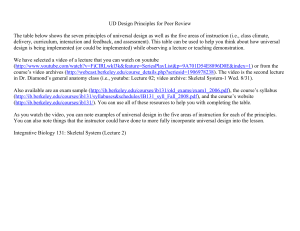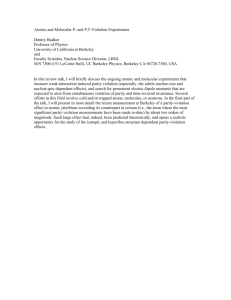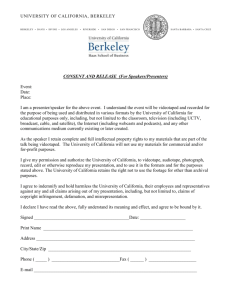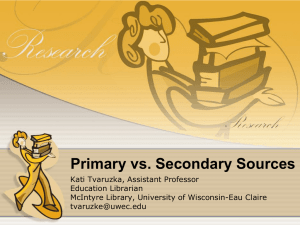BS_020_Rickless_Review
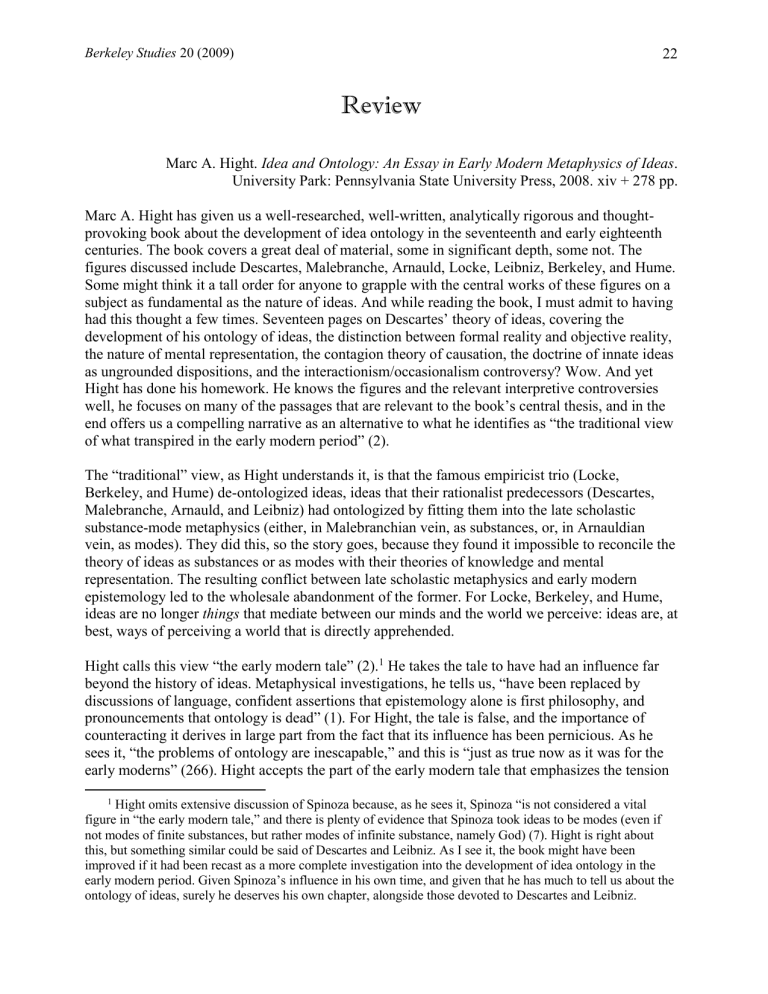
Berkeley Studies 20 (2009) 22
Review
Marc A. Hight. Idea and Ontology: An Essay in Early Modern Metaphysics of Ideas .
University Park: Pennsylvania State University Press, 2008. xiv + 278 pp.
Marc A. Hight has given us a well-researched, well-written, analytically rigorous and thoughtprovoking book about the development of idea ontology in the seventeenth and early eighteenth centuries. The book covers a great deal of material, some in significant depth, some not. The figures discussed include Descartes, Malebranche, Arnauld, Locke, Leibniz, Berkeley, and Hume.
Some might think it a tall order for anyone to grapple with the central works of these figures on a subject as fundamental as the nature of ideas. And while reading the book, I must admit to having had this thought a few times. Seventeen pages on Descartes’ theory of ideas, covering the development of his ontology of ideas, the distinction between formal reality and objective reality, the nature of mental representation, the contagion theory of causation, the doctrine of innate ideas as ungrounded dispositions, and the interactionism/occasionalism controversy? Wow. And yet
Hight has done his homework. He knows the figures and the relevant interpretive controversies well, he focuses on many of the passages that are relevant to the book’s central thesis, and in the end offers us a compelling narrative as an alternative to what he identifies as “the traditional view of what transpired in the early modern period” (2).
The “traditional” view, as Hight understands it, is that the famous empiricist trio (Locke,
Berkeley, and Hume) de-ontologized ideas, ideas that their rationalist predecessors (Descartes,
Malebranche, Arnauld, and Leibniz) had ontologized by fitting them into the late scholastic substance-mode metaphysics (either, in Malebranchian vein, as substances, or, in Arnauldian vein, as modes). They did this, so the story goes, because they found it impossible to reconcile the theory of ideas as substances or as modes with their theories of knowledge and mental representation. The resulting conflict between late scholastic metaphysics and early modern epistemology led to the wholesale abandonment of the former. For Locke, Berkeley, and Hume, ideas are no longer things that mediate between our minds and the world we perceive: ideas are, at best, ways of perceiving a world that is directly apprehended.
Hight calls this view “the early modern tale” (2).
1
He takes the tale to have had an influence far beyond the history of ideas. Metaphysical investigations, he tells us, “have been replaced by discussions of language, confident assertions that epistemology alone is first philosophy, and pronouncements that ontology is dead” (1). For Hight, the tale is false, and the importance of counteracting it derives in large part from the fact that its influence has been pernicious. As he sees it, “the problems of ontology are inescapable,” and this is “just as true now as it was for the early moderns” (266). Hight accepts the part of the early modern tale that emphasizes the tension
1 Hight omits extensive discussion of Spinoza because, as he sees it, Spinoza “is not considered a vital figure in “the early modern tale,” and there is plenty of evidence that Spinoza took ideas to be modes (even if not modes of finite substances, but rather modes of infinite substance, namely God) (7). Hight is right about this, but something similar could be said of Descartes and Leibniz. As I see it, the book might have been improved if it had been recast as a more complete investigation into the development of idea ontology in the early modern period. Given Spinoza’s influence in his own time, and given that he has much to tell us about the ontology of ideas, surely he deserves his own chapter, alongside those devoted to Descartes and Leibniz.
Berkeley Studies 20 (2009) 23 between early modern metaphysics and early modern epistemology as applied to ideas. But, on his view, the early moderns tried with varying degrees of success to eliminate the tension without abandoning the classical substance-mode ontology, and in doing so offered us examples of some of their very best philosophical work. Hight concludes that to deny “the spectacular metaphysical speculations of the early moderns is to rob us today of what they did best” (267).
Given how much there is to be said about the views of each of the relevant historical figures, it comes as something of an initial surprise that the book devotes as much space as it does to the views of Berkeley in particular. Whereas each of Descartes, Locke, Leibniz, and Hume gets his own chapter (and Malebranche and Arnauld are given one to share), Hight graces Berkeley with three chapters covering almost half of the 230 pages devoted to the study of particular figures.
This decision is a boon for Berkeley fans (of whom I am one), but it does give the book a decidedly unusual tilt. For many scholars of the early modern period, Berkeley is a transitional figure at best, an intellectual way-station from one giant (Locke) to another (Hume). Hight is right, I think, both that this way of reading Berkeley is uncharitable and that there is a great deal to be learned from the way in which Berkeley in particular attempted to reconcile the metaphysics of (human) ideas with the epistemology of perception and representation. But he could have achieved this aim without delving, as he does, into Berkeley’s theory of divine ideas (chapter 7), abstract ideas (chapter 8.1-4), or perceptual heterogeneity (chapter 8.5-10). Chapters 7 and 8 are based in significant part on Hight’s previously published work, but, even granting the intellectual significance of this work, one wonders whether it might not have been better for the book if Hight had removed those chapters and had included them in a separate monograph dedicated to
Berkeley alone instead.
The bulk of my review focuses on the part of Hight’s book that is devoted to Berkeley, specifically on chapters 6 and 7. But before discussing Berkeley, I want to raise one important question about the book’s main thrust. Is the early modern tale in fact the “traditional” or standard picture of the development of idea ontology in the early modern period? Hight takes for granted that it is, but his evidence for this claim is pretty thin. Hight takes John Yolton, Richard Watson, and Thomas Lennon to be the main purveyors of the early modern tale. These are three influential commentators, but if the early modern tale were the traditional view that Hight takes it to be, one would expect there to be more published purveyors of it. But, so far as I can tell, Hight does not refer to any other purveyors. I suspect that the main reason for this is that Yolton, Watson, and
Lennon are actually a distinct minority among early modern scholars. The reason why Yolton’s work made such a splash was that it went against the grain to suggest that any of the early moderns had de-ontologized ideas. Yolton was worried that the epistemic “veil of perception” problem (to the effect that the existence of perceived intermediary objects between perceivers and external world objects conduces to external world skepticism) would lead us all to think less of the early moderns. And his clever suggestion was to rehabilitate at least some of the early moderns by finding reasons to think that they were not committed to ideas as intermediaries. But this went against the standard view, according to which the moderns of the 18 th
century reacted to the “veil of perception” problem that had bedeviled the early moderns of the 17 th century (notably
Descartes and Locke) either by turning the objects of sense into collections of ideas (Berkeley,
Hume, and, in a way, Kant) or by adopting some form of direct realism (Reid). If I am right that the purveyors of the early modern tale are really few and far between, then Hight’s book is best read as a well-reasoned rejection of an influential minority position on the relevant issues.
Berkeley Studies 20 (2009) 24
Let me now turn to Hight’s interpretation of Berkeley’s views on idea ontology. Hight’s main claim is that Berkeley tried “to save the philosophy of ideas within the ontology of substance and mode” (244). He did this (i) by “stretch[ing]” the ontology “to make room for a new category within
” it (8, 138), a category that Hight calls “quasi-substance” (8), and (ii) by slotting ideas into this new category.
2
In contradistinction to the early modern tale, Hight insists that “Berkeley did not abandon ontology with respect to ideas, [but rather] modified and improved it” (138).
In order to understand Hight’s notion of quasi-substance, it is important to understand his conception of traditional substance-mode ontology. According to Hight, all the early moderns accepted a “core” conception of substance (18) and a “core” conception of mode (21). According to the core conception of substance, a substance possesses two characteristics: endurance and independence (14). For Hight, an entity endures (i.e., qualifies as a “thing”) when it “survives and underlies change without itself changing or is able to have contrary properties at different times without sacrificing its identity” (12). As Hight sees it, independence is a genus of which there are various species, most notably simplicity, causal independence, ontological independence, and volitional independence (14, 141). An entity is simple if it has no parts (and thus does not depend for its existence on the existence of any parts); it is causally independent if “it requires no external cause for its being” (18); it is ontologically independent if its existence does not require the existence of something else (14); and it is volitionally independent if it exists whether or not one wills it to exist (158). Hight argues that all of the early moderns took endurance and independence to be defining marks of substance, some hewing to one, others hewing to another conception of independence.
3
According to the core conception of mode, a mode possesses endurance, but not independence:
“substances are independent things; modes are dependent things” (22). Hight highlights the endurance of modes. He claims that “there are two competing understandings of modes among the moderns.” According to the first “transcendental” understanding, modes are instances of universals; according to the second “immanent” understanding, modes are “more like particular individuals” (21-22). On either of these “understandings,” modes endure. In this, then, modes are like substances. Modes differ from substances in that the former, but not the latter, are dependent beings. In Hight’s words, “the independence criterion is paramount in separating modes from substances” (20).
According to Hight, Berkeley carves out a new ontological category, that of quasi-substance.
Though they are neither substances nor modes, quasi-substances possess characteristics of both.
On the one hand, quasi-substances “possess one feature usually reserved for substances, namely a
2 Hight writes that “Berkeley stretches the ontology such that it becomes decidedly less rigid and exclusive”
(11 n.1), and that “Berkeley implicitly denies that the substance/mode ontology is exclusive or exhaustive”
(141). But these sentences mischaracterize Hight’s own thesis. As Hight conceives it, Berkeley’s version of the substance-mode ontology is no less exclusive than the traditional version: for Berkeley, as for his predecessors and contemporaries, no substance can be a mode, and no mode can be a substance. Berkeley’s main innovation, on Hight’s view, consists in abandoning the exhaustiveness , but not the exclusiveness , of the traditional ontology.
3 As Hight reads them, Descartes, Locke, Malebranche, and Arnauld take endurance and ontological independence to be sufficient for substancehood, while Leibniz (for fear that acceptance of these criteria will lead to the Spinozistic thesis that there is only one substance, namely God) characterizes substances as enduring, simple, and causally independent (12-20).
Berkeley Studies 20 (2009) kind of separation from other entities such that they are neither modes nor proper parts of other substances”; on the other hand, quasi-substances “possess the one feature most distinctive of modes: they are ontologically dependent on these distinct substances” (35). As Hight sees it,
Berkeley’s main contribution to idea ontology—a contribution with considerable “philosophical payoff” (176)—is that ideas are quasi-substances in this sense.
25
Now right at the start we can begin by asking whether Hight’s conception of the traditional substance-mode ontology is in fact as traditional as he thinks it is. Hight rightly refers us to
Aristotle’s
Categories as the source of the traditional ontology. But Aristotle’s criteria for substancehood differ, at least at first blush, from the criteria Hight himself identifies as forming the “core” conception of substance. As Hight himself recognizes, Aristotle writes that “a substance—that which is called a substance most strictly, primarily, and most of all—is that which is neither said of a subject nor in a subject” (12). Thus, Socrates is a (primary) substance in that (i) he (or better, the word “Socrates”) cannot be said of (i.e., predicated of) anything (unlike white, which can be predicated of a piece of chalk), and (ii) he is not in anything (unlike white, which is in the piece of chalk). These two criteria, of impredicability and lack of inherence respectively, are completely different from the criteria of endurance and independence.
So, as Hight represents it, the early modern “core” conception of substance is quite different from
Aristotle’s, and therefore seems to be more novel than it is traditional. But Hight insists that the early moderns did look to some of Aristotle’s statements about substance for inspiration. Aristotle does suggest that substances, though not predicated of other things, are themselves subjects of predication. As Hight puts the point, a substance is a substratum, namely something “that receives and supports qualities” (12). Thus, a piece of chalk is a substance inasmuch as “white” can be predicated of it and whiteness inheres in it.
Hight seems to think that the “substratum” criterion reduces to, or at least entails, the endurance criterion. For he writes that a conception of substance as a support for qualities “is one of endurance—there must be some thing that persists to underlie, support, and unify the qualities”
(15). But there is confusion here, for there is no relation of entailment (or inter-entailment) between the two criteria. It is certainly possible for X to serve as a support for qualities without
X’s being capable of surviving change. We can certainly imagine a series of numerically distinct supports for each of the different sets of qualities that appear to inhere in a single substance over time. And we can certainly imagine an enduring thing that does not itself serve as a support for qualities.
So the “substratum” criterion is a third criterion of substancehood, one that differs from both endurance and independence. Moreover, its reverse serves as a third criterion of modehood. For if a substance can be defined as something that functions as a support, then a mode can be defined as whatever it is that plays the role of being supported.
Thus far, though, the addition of a third criterion of substancehood merely complicates, but does not overturn, Hight’s conception of the relevant criteria. Amending Hight’s thesis, we could say that on the traditional conception a substance is an enduring and independent substratum, and a mode is an enduring entity that is supported by something on which it also depends (namely, a substratum). Is there anything wrong with this picture? I think there is.
Berkeley Studies 20 (2009) 26
According to the traditional substance-mode ontology, so Hight tells us, the substance/mode dichotomy is exhaustive: everything that is not a substance is a mode, and everything that is not a mode is a substance. But, as Hight himself notes, philosophers such as Descartes and Spinoza countenanced attributes, in addition to modes and substances. Descartes, for instance, tells us that thought is the attribute of mind and extension is the attribute of body. Are all attributes modes?
Hight waffles on this point. On the one hand, Hight tells us that attributes “are subject to the same conceptual limits as modes,” for, like modes, attributes “depend on substances for their being.”
Indeed, so Hight claims, attributes are “more inter dependent with their substances, since they are essential to them” (21). Thus, it appears that an attribute is just one special kind of mode, namely an essential mode. On the other hand, Hight recognizes that “not all attributes are modes” (20-21).
These statements about attributes can’t all be true. This strongly suggests that something is awry with Hight’s conception of the traditional substance-mode ontology. The problem seems to be that attributes possess features that are characteristic of substances and also possess features that are characteristic of modes, without being either substances or modes. But if this is so, then the traditional substance-mode dichotomy, as encapsulated in the work of Descartes and others, is not exhaustive. What to do?
The answer, I believe, is to give up Hight’s understanding of the traditional conception of a mode.
As Hight sees it, a mode is an enduring thing that is neither independent nor a substratum.
Unfortunately, this characterization of a mode fits the Cartesian conception of an attribute more closely than it fits the Cartesian conception of a mode. And it is not merely true to say, as Hight does, that “not all attributes are modes.” What is true is more radical than this, namely that no attributes are modes. Hight assumes that the main difference between attributes and modes is that attributes are essential characteristics, while modes are accidental characteristics, of substances.
But this papers over the main difference, which concerns the very nature of these characteristics.
Hight is right that attributes are essential properties of substances: according to Descartes, thought is essential to mind, and extension is essential to body. But modes are not merely inessential properties of substances: rather, as the etymology of the word “mode” suggests, modes are ways of possessing this or that attribute. Thus, willing and perceiving, which are modes of mental substance, are ways of thinking; and shape and size, which are modes of corporeal substance, are ways of being extended.
On this conception of the traditional substance-mode ontology, the characteristics Hight ascribes to modes are truer of attributes. Attributes are persistent characteristics that survive and underlie change. So attributes endure. Modes, by contrast, do not. This or that episode of willing or perceiving, this or that shape or size, is momentary, rather than persistent. Indeed, it is not even clear that modes are things . A mode is not a thing, but rather a way for a thing to be (or a way for a thing to possess this or that characteristic). But not all of the characteristics that Hight ascribes to modes are true of attributes. Hight’s modes are dependent beings; on the most common “core” conception, they are ontologically dependent beings. But Cartesian attributes, at least arguably, possess the same kind of ontological independence that substances have. Thought and extension are true and immutable natures that would exist even if there were no actual thinking things and no actual extended things. In this sense, thought exists independently of the mind of which it is the essence, and extension exists independently of the body of which it is the essence. The crucial
Berkeley Studies 20 (2009) difference between attributes and substances, it seems, is that substances, but not attributes, are substrata.
27
I conjecture therefore that Hight’s inability to classify attributes within the traditional substancemode ontology derives at least in part from his inability to recognize the substratum criterion as separate from both the endurance and independence criteria. Once it becomes clear that there are three, rather than two, criteria, the way is open to a proper understanding of substances, modes, and attributes. Importantly, what becomes evident is that modes are ways of being, not things themselves.
Here is another, more ad hominem , way of reaching the same conclusion. Hight argues that in deciding whether ideas are more like substances or more like modes, “we can look to see whether a given philosopher takes perception to be a monadic property or dyadic relation. In dyadic relations the relata are distinct and usually (but not always) thought of as independent of one another. Hence the relata are thought of as substances. When taken to be monadic properties, ideas are treated as modes” (22). So, for Hight, whether a philosopher conceives of perception as dyadic or monadic reveals whether he or she thinks of ideas as more substance-like or more mode-like.
But there is confusion here too. If perception is monadic, then to see red (say) is not to be related to something by the relation of seeing: it is, perhaps, to see redly, but nothing more. Indeed, the best monadic account of perception I can think of is the adverbial one. But on such a monadic account, if ideas play any role in perception, then they are not Hightian modes. For, according to
Hight, modes are things that could serve as the relata of dyadic perceptual relations. To put the same point another way: the dyadic conception of perception is fully compatible with the view that ideas are Hightian modes. In the end, the best way to preserve the connection Hight sees between the dyadic conception of perception and the thought that ideas are more substance-like than mode-like is to abandon the claim that modes are things and instead embrace the view that modes are ways for things to be.
Hight may resist the claim that modes are not things , even were he to accept that modes do not endure. This is because Hight identifies a criterion of thinghood distinct from the criterion of endurance, namely Quine’s famous dictum that to be is to be the value of a variable.
4 A thing, in this sense, is “that over which one quantifies” (23). Using this criterion, it becomes clear that modes are things, for it is possible to quantify over them. But, as Hight himself recognizes, it is only in a very “minimal” sense that a Quinean thing is a thing (24). In this sense, even ways of being are things. (Think of that famous first line of Elizabeth Barrett Browning’s sonnet: “How do I love thee? Let me count the ways.”) What I am suggesting is not that modes are not things in
Quine’s sense
, but rather that modes are not things in the sense of persisting entities that underlie change.
5
4 See W. V. O. Quine, “On What There Is,” in From a Logical Point of View , 2 nd ed., rev. (Cambridge, Ma.:
Harvard University Press, 1980), 15.
5 At one point, Hight claims that “we can have modes as well as modes of modes” (26). But if I am right that modes are ways for substances to be, then there could be no such thing as a mode of a mode, for there could be no such thing as a way for a way for a substance to be to be.
Berkeley Studies 20 (2009) 28
If this is right, then Hight’s claim that there are two traditional conceptions of modes, namely as akin to universals and as akin to particulars, is inaccurate. An episode of willing (say, a volition to eat a doughnut) is a mode of thought, a way for a mind to think, but it is neither akin to a universal nor akin to a particular. For a mode is not a thing in the relevant sense.
Hight is right about one important feature of modes: they are indeed ontologically dependent, i.e., dependent for their existence, on the substances they modify. But this ontological dependence is not a rock-bottom feature of modes: the fact that modes are ontologically dependent derives from their very nature as modes. For modes are essentially relative entities: if X does not exist, then there could not be a way for X to be.
Let us then return to the question of the ontological status of ideas in Berkeley’s metaphysics.
Hight claims that Berkeley’s ideas are neither substances nor modes. The fact that they are not substances, Hight says, derives from their ontological dependence. And this seems right. The fact that they are not modes, Hight says, derives, in the first instance, from the fact that they
“possess…a kind of separation from other entities” (35). But what does this “separation” amount to? Hight writes (140):
Near the beginning of the Principles , in section 2, we are told that the mind is “a thing entirely distinct” from ideas. One main theme in his works is that the activity of the mind contrasts with the passivity of ideas. In light of this contrast, it is difficult to allow that he thinks modes are sufficiently distinct from minds to qualify as ideas.
6
Hight seems to be arguing that, for Berkeley, the fact that ideas are passive while minds are active indicates that ideas are not modes. But this does not follow. Modes, whether conceived as Hight does or as ways of possessing attributes are surely passive, rather than active. So it is not at all clear why we should believe that Berkeley does not take ideas to be modes of mental substance.
As it happens, Hight provides a number of reasons for thinking that Berkeley’s ideas are not modes of minds. In one place, he writes that, for Berkeley, “God’s ideas…being distinct relata in a two-place relation with the mind [implies] that they are neither modes nor proper parts of the divine mind” (181-182). But, interestingly, as I have argued, on Hight’s conception of a mode as an enduring thing, the claim that ideas are relata of dyadic relations is perfectly compatible with the view that they are modes. Indeed, the best way to defend the claim that it is on the strength of their being relata of dyadic relations that ideas are not modes is to suppose that modes are not things, but rather, as I have argued, ways of possessing attributes.
Another reason Hight gives for thinking that Berkeley denies that ideas are modes is that, for
Berkeley, ideas are “external” to the mind in the sense of being volitionally independent of it (158,
160). Now Hight is surely right that Berkeley’s ideas of sense do not depend for their existence on the wills of the human minds that perceive them: even if I willed to not perceive a computer screen right now, I would still perceive it as I write. But the fact that some ideas are independent of our wills does not entail that all ideas are independent of our wills. And, indeed, as Hight himself recognizes, some of our ideas (namely, ideas of imagination) would not exist if we did
6 By the last sentence of this passage, I take it that Hight means that it is difficult to allow that Berkeley thinks ideas are sufficiently distinct from minds to qualify as modes .
Berkeley Studies 20 (2009) not will them to exist. Should we then say that, for Berkeley, some ideas are modes by virtue of their volitional dependence while others, being volitionally independent, are not? Surely not. If there is anything we can say with confidence about Berkeley’s conception of ideas, it is that all ideas, regardless of their relation to our wills , possess the same ontological status.
29
The best reason Hight cites for thinking that Berkeley’s ideas are not modes is that, for Berkeley, whereas modes are predicable of the substances they modify, ideas are not predicable of minds
(154—see Principles 49). Two features of this argument are particularly noteworthy, at least in relation to the rest of Hight’s book. The first is that this argument relies on what I identified as the third criterion of modehood, one not mentioned by Hight, namely the view of modes as predicable of (or supported by) the substances they modify. The second is that if this is one of Berkeley’s main reasons for thinking that ideas are not modes, then it is a reason that Berkeley’s predecessors share! Indeed, Descartes no more accepts that ideas (such as redness and roundness) are predicable of minds than does Berkeley. It follows, then, that Berkeley’s insistence that ideas differ from modes does not constitute the kind of philosophical innovation that Hight takes it to be.
If there is any reason to suppose that Berkeley took ideas to be modes, it is that Berkeley took ideas to be ontologically dependent on the minds that perceive them. For, as Hight recognizes, “if ideas are modes, then Berkeley has an immediate and intuitive answer to the question of why he thinks ideas must be dependent on minds[:] the esse of ideas is percipi because ideas are literally modifications of the mind” (154). But, as we’ve seen, Hight denies that Berkeley’s ideas are modes. So he needs to explain why Berkeley “was so thoroughly convinced that ideas had to be such dependent beings” (154). Hight’s answer is that Berkeley, “like his predecessors, built
[dependence] into the concept of an idea…Berkeley was, of course, right when he said that everyone agreed with this claim. It was not an assertion for which he thought he needed to argue.
Instead, the dependence of ideas was a foundational premise he thought obviously true because, in part, everyone thought it was obviously true” (154-155). But it is worth noting that many of
Berkeley’s predecessors thought it obviously true that ideas are ontologically dependent precisely because they took ideas to be modes ! According to Hight, this sort of reasoning is unavailable to
Berkeley, and hence it makes no sense to suppose that he took the dependence of ideas to be obvious in exactly the way his predecessors did.
Rather, it makes more sense to suppose that Berkeley took ideas to be dependent on minds because he had a particular theory of the meaning of existence-claims about ideas. At Principles
3, Berkeley writes that it seems no less evident that the various sensations or ideas imprinted on the sense…cannot exist otherwise than in a mind perceiving them. I think an intuitive knowledge may be obtained of this, by any one that shall attend to what is meant by the term exist when applied to sensible things. The table I write on, I say, exists, that is, I see and feel it….There was an odour, that is, it was smelled; there was a sound, that is to say, it was heard; a colour or figure, and it was perceived by sight or touch. This is all that I can understand by these and the like expressions.
Berkeley Studies 20 (2009) 30
Berkeley’s claim here is that there is something special about the meaning of existence-claims about ideas , such that their meaning is distinct from the meaning of existence-claims about minds .
To say that such-and-such idea exists is to say that it is perceived. To say that such-and-such mind exists is to say no such thing. It is this fact about meaning, above all else, that grounds Berkeley’s thesis that the esse of an idea is percipi , and that therefore grounds his claim that ideas are ontologically dependent on the minds that perceive them.
What, then, is Berkeley’s conception of the ontological status of ideas? Hight is right that ideas are not substances, for the only substances in Berkeley’s ontology are minds, and ideas differ from minds in that the latter are active while the former are passive. And Hight is also right, I think, that Berkeley’s ideas are not modes. But the reasons Hight gives for this are not Berkeley’s.
A mode is a way for a substance to be. In this sense of mode, which Hight does not recognize, ideas are not modes, for ideas, unlike modes, are relata of dyadic relations, and modes, unlike ideas, are predicable of minds. Berkeley’s inability to slot ideas within the classical substancemode ontology, however, is not unique to him: it bedeviled his predecessors and contemporaries, and almost certainly contributed to the eventual demise of classical Aristotelian metaphysics.
There is little reason to suppose that it was Berkeley’s design, explicit or implicit, to carve a new ontological category of quasi-substance (or quasi-mode) within the classical framework of substance and mode. What we can say, rather, is that Berkeley struggled to identify the ontological status of ideas precisely because the ontological categories with which he was familiar did not permit him to do so. It does not follow, of course, that Berkeley de-ontologized ideas. To the contrary, as Hight well documents, many of Berkeley’s ideas, such as houses, mountains, and rivers, are surely things , things that exist and things that are real . But the true status of ideas in relation to substance-mode ontology, for Berkeley, remains a mystery.
Hight claims that thinking of Berkeleyan ideas as quasi-substances helps us understand otherwise puzzling aspects of Berkeley’s philosophy, including his theory of divine ideas, his polemic against abstract ideas, and his defense of perceptual heterogeneity. Though Hight’s discussion of each of these topics is rewarding and deserving of extensive commentary, for reasons of space I will focus attention only on the first.
Hight’s main interpretive thesis on the topic of divine ideas is that “the sensory ideas perceived by finite minds are numerically identical to God’s divine ideas” (178). If the numerical identity thesis, as I will call it, is true, then my sensory ideas are not private to me, for God perceives them just as I do.
7
Hight does not clearly explain why discussion of this thesis is important to the main argument of the book, but it is of some considerable interest to Berkeley scholars nonetheless.
Hight’s main reason for thinking that Berkeley endorsed the numerical identity thesis is that its negation would leave room for the kind of skepticism to which Berkeley was implacably opposed.
He writes:
Berkeley cannot consistently allow [that the ideas we directly perceive are distinct from the divine ideas that constitute sensible reality] without serious risk of skepticism, since the ideas
7 Hight claims that it is “logically possible, but not required by Berkeley’s system” that “the ideas had by two finite minds are therefore numerically identical as well” (209).
Berkeley Studies 20 (2009) 31 we perceive would then constitute an intermediary between the real world and our knowledge of it. (184)
The point remains that asserting numerical identity between our sensory ideas and God’s ideas is epistemologically necessary from Berkeley’s point of view to defeat skepticism. (188)
Hight’s idea here is that if our ideas of sense were numerically distinct from God’s ideas, then, although we would have epistemic access to our ideas, we would not have such access to God’s ideas; and if the real world were constituted by God’s ideas, then we would have no epistemic access to the real world. But if there is anything about which Berkeley is adamant, it is that we have such access. Indeed, it is partly because Berkeley takes materialists to be committed to the view that we have no such access that he is as committed as he is to the otherwise surprising doctrine of immaterialism.
The problem with this line of reasoning is that the real world, as Berkeley sees it, is constituted by the ideas of finite minds. In Principles 36, Berkeley writes that things are more real to the extent that they are “more affecting, orderly, and distinct.” “The real sun,” he says, is “the sun that I see by day,” and “it is evident that every vegetable, star, mineral, and in general each part of the mundane system, is as much a real being by our principles as by any other.” The real world, then, is constituted by the objects that common sense tells us are perceived by finite minds, namely sun, stars, mountains, rivers, rocks, tables, animals, and so on. These objects are congeries of ideas of sense, ideas perceived by (and hence, by Berkeley’s lights, existing in) finite minds. As long as finite minds have epistemic access to their own ideas, then, even if God’s ideas are epistemically inaccessible to them, they still have epistemic access to the real world. The numerical identity thesis is therefore not needed to ward off the threat of real world skepticism.
It is true, as Hight emphasizes, that the falsity of the numerical identity thesis opens up the possibility that there is a part of “reality” (namely, the contents of the divine mind) to which finite minds have no epistemic access. This is a kind of skepticism, but it is not the kind of skepticism that worries Berkeley or any of his contemporaries. Because God is perfect, because his mind is infinite, because he works in mysterious ways, it is to be expected , both on philosophical and theological grounds, that his mind is beyond our ken. Berkeley claims to know (on the basis of proof) that God exists, but does not claim that he has any conception of what God is truly like.
Like most of his fellow theists, Berkeley is suitably modest about the extent of the knowledge of
God of which finite minds are capable. This is not the skepticism that haunts materialism: it is merely the contrary of epistemic arrogance.
8
8 Hight writes: “Anything that separates us from the real nature of things produces skepticism. The claim is perhaps more obviously true for material substances, but it would nonetheless cause embarrassment if it turned out that the ideas we perceive are not in fact real things but only copies of them. Even if one were to suppose that our ideas were copies of God’s ideas, doubt could reemerge concerning the perfection of the copies. And
Berkeley does not believe his system will allow for any doubt” (184-185). There is something right here, but also something wrong. It is true that “anything that separates us from the real nature of things produces skepticism.” But it is false that skepticism of the relevant sort follows from the claim that our ideas are no more than copies of God’s ideas. This is because the real nature of things is constituted by our ideas, not by God’s ideas.
Berkeley Studies 20 (2009) 32
Hight rightly points out that the numerical identity thesis, if true, would explain and underwrite the continuity of sensible objects: “the tree I see outside my window,” he writes, “is the ‘same’ tree as I saw five minutes ago, because its continuity is preserved in a divine world of ideas to which I have access” (205). But it should be noted that the continuity of sensible objects in
Berkeley’s system does not require the truth of the numerical identity thesis. In order to explain and underwrite this continuity, Berkeley need only hypothesize that God continues to perceive our ideas after we have ceased perceiving them. God sees all things, including the things we see.
This much is philosophically and theologically straightforward. So when I turn my head, the tree I was looking at does not disappear, but the reason need not be that the tree is numerically identical to an idea (or congeries of ideas) in God’s mind. In order to ensure continuity, it is sufficient that
God perceive the tree after I have ceased perceiving it.
So Hight does not provide strong reasons for attributing the numerical identity thesis to Berkeley.
Moreover, there are strong textual reasons for thinking that Berkeley adopted the contrary thesis instead. Hight recognizes that Berkeley sometimes uses the nomenclature of “divine archetypes”
(185), a phrase that, along with the word “ectype” as applied to the ideas in finite minds, strongly suggests that the latter are copies of, and hence not numerically identical with, God’s ideas. One such passage appears in the Third Dialogue
: “Again, the things I perceive must have an existence, they or their archetypes , out of my mind: but being ideas, neither they nor their archetypes can exist otherwise than in an understanding” (W2, 240—emphasis added). Another, more significant passage, appears in Berkeley’s correspondence with Samuel Johnson. There Berkeley writes:
I have no objection against calling the ideas in the mind of God archetypes of ours. But I object against those archetypes by philosophers supposed to be real things, and to have an absolute rational existence distinct from their being perceived by any mind whatsoever. (W2:
292-94)
Reacting to this passage, Hight writes (186):
I cannot explain why Berkeley refuses to straightforwardly admit to Johnson that God’s ideas are numerically identical to the ideas of sense had by finite minds (and hence refuses to deny that God’s ideas are strictly speaking archetypes in the sense of being originals of which we have copies), but the exchange is suitably odd as to convince me that something is amiss in the correspondence.
Hight also points to a passage from the Third Dialogue in which Philonous remarks to Hylas: “It is your opinion, the ideas we perceive by our senses are not real things, but images, or copies of them. Our knowledge therefore is no farther real, than as our ideas are the true representations of those originals. But as these supposed originals are in themselves unknown, it is impossible to know how far our ideas resemble them; or whether they resemble them at all” (W2, 246). Commenting on this, Hight writes: “The explicit target here, of course, is material archetypes, but the point also applies perfectly well against immaterial archetypes. Any view that creates a numerical difference between the ideas that constitute genuine reality and the (sensory) ideas had by finite minds will engender skepticism” (185). But, again, although it is true that denying the numerical identity thesis opens up the possibility of skepticism regarding the question of whether or how the ideas in finite minds resemble divine ideas , the fact that the real world is constituted by the ideas in finite minds closes off the possibility of skepticism about the real world . And it is the latter kind of skepticism, not the former, to which
Berkeley is opposed.
Berkeley Studies 20 (2009) 33
But there is really nothing amiss here. In his letter to Johnson Berkeley more than merely refuses to admit that the numerical identity thesis is true : he is quite clearly willing to accept that the numerical identity thesis is false . This is the point of his claim that he has “no objection” against calling divine ideas “archetypes” of ours. Further, Berkeley emphasizes that acceptance of divine archetypes is not akin to acceptance of materialist archetypes. The latter, says Berkeley, are supposed to constitute the real world and are supposed to be capable of existing unperceived. By contrast, Berkeley does not suppose that the divine archetypes constitute the real world—the real world is constituted by the relevant ectypes, and does not suppose that the divine archetypes are capable of existing unperceived—the divine archetypes are ideas , and no idea can exist unperceived.
All told, Hight offers us an elegant and novel interpretation of Berkeley’s ontology of ideas, situated in its proper historical context. The thesis that Berkeley’s ideas are quasi-substances is interesting and thought-provoking, but in the end unconvincing. And the thesis that Berkeley’s ideas of sense in finite minds are numerically identical to ideas in the mind of God is belied by the text. These are some of Hight’s central ideas, but not by any means the only ones. The text of
Hight’s book is rich in content and I found myself in agreement with many of his claims and arguments, most notably his criticisms of proponents of the early modern tale, according to whom
Berkeley played an important role in the de-ontologizing of ideas. Because of its overall depth and rigor, I strongly recommend the book for all who are interested in Berkeley’s metaphysics and epistemology, as well as Berkeley’s role in the historical development of the way of ideas more generally.
Samuel C. Rickless
University of California, San Diego srickless@ucsd.edu


